In the November/December 2023 issue of RCCL, we published a feature exploring the numerous options in the soft multifocal (MF) contact lens (CL) market. In the present article, we plan to tackle the other category of MF lenses: rigid gas-permeable (RGP) CLs. Patients with irregular corneas, higher or out-of-range prescriptions or greater visual demands will benefit most from these specialty designs compared to non-custom soft lenses.
RGPs provide crisp vision, good ocular health and are typically cost-effective.1 When asked to consider visual acuity, one study found that 75% of patients with astigmatism preferred the performance of rigid over soft CLs.2 Multifocal GPs have also been shown to provide better quality of vision than soft MFs.1
Despite their many advantages, GP MFs made up only 1% of all fittings in the United States in 2022, while soft multifocal contact lenses made up 12%.3 Barriers to their broader acceptance may include the absence of an immediate on-eye experience, upfront costs, risk of initial discomfort, absence of frequent replacement modalities, complexity of fitting MF GPs and the danger of corneal molding with some of the aspheric designs.4 However, the arrival of a new generation of hybrid GPs and scleral lenses, as well as improved designs of corneal GPs, has created a renewed interest in fitting these lenses.
Lens Designs: Pros and Cons
When considering vision correction and level of customization among the many lens designs—aspheric, concentric, extended depth-of-focus (EDOF) and alternating/translating—each has notable strengths and weaknesses. Before laying out all the unique products in today’s market, we’ll first discuss the potential advantages and drawbacks of the numerous rigid MF lens designs to consider when selecting and fitting patients.
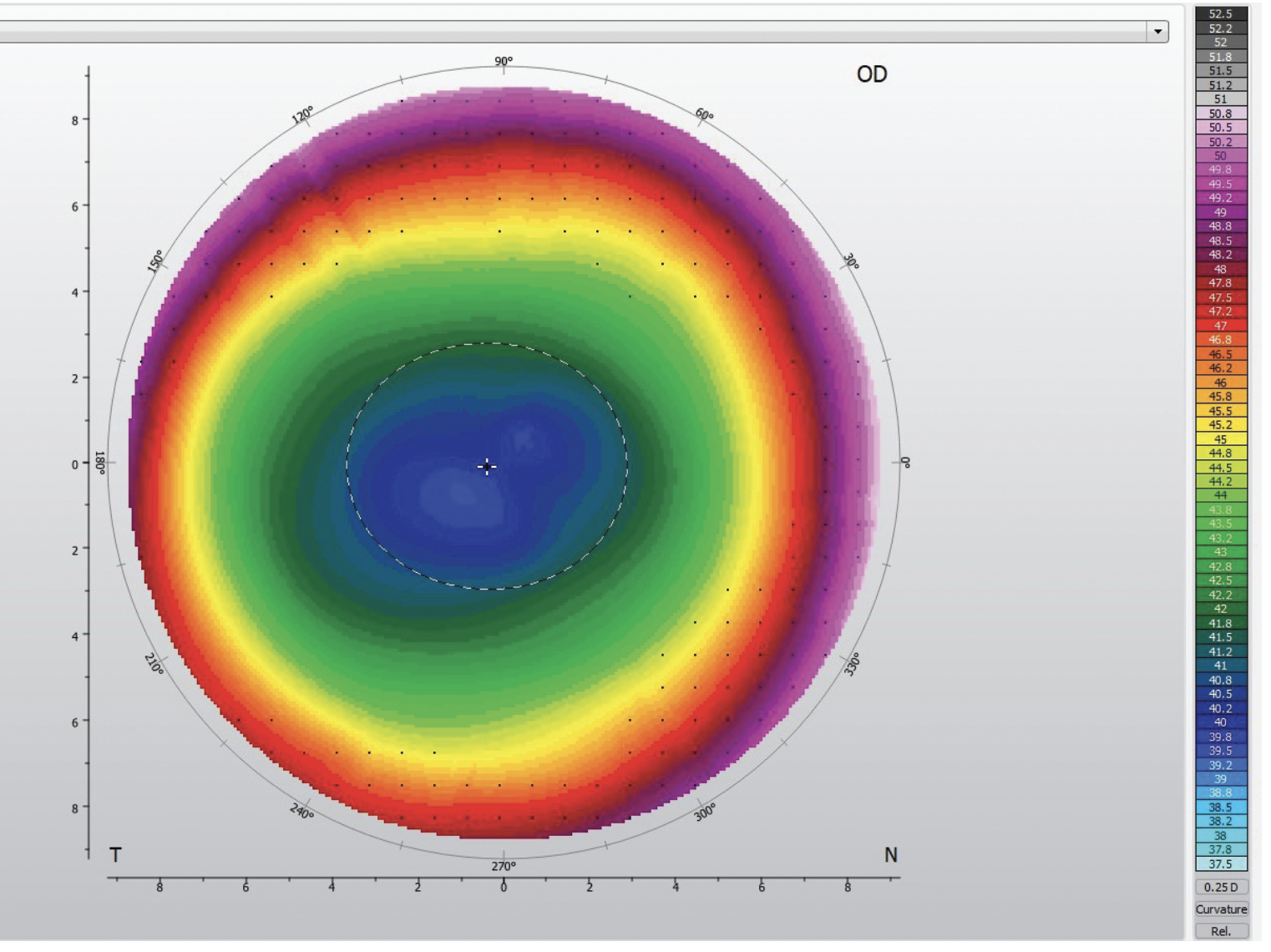 |
|
Fig. 1. Topography of a center-distance aspheric corneal GP. Aspheric lenses often employ a center-distance zone that gradually increases in power to a near peripheral zone. Photo: Cory Collier, OD. Click image to enlarge. |
Aspheric Designs
This approach uses eccentric shaping on the front and/or back surfaces to create a gradual blending of add power (Figure 1). These power profiles can change at varying rates across different zone diameters.5 Center-near profiles are particularly effective for moderate to advanced presbyopes because the add is centered around the visual axis giving better acuity at near. Back-surface aspheric center-near MFs are often fit 1.50D to 3.00D steeper than flat keratometric values to create a higher plus power tear lens. A disadvantage of this design is the risk of corneal molding under the lens because of the steep fitting relationship. This can cause steepening that leads to myopic shift and, ultimately, temporary spectacle blur after lenses are removed.
There are now many aspheric designs that use front-surface eccentricity to generate the add power. Each of these designs is an example of simultaneous vision, which requires adaptation and, in the case of center-near designs, suppression. It is often necessary for the patients to trial these designs for several weeks to adapt to having both distance and near vision simultaneously inside the pupil.
Considering pupil size is extremely important when fitting aspheric lenses, since patients with small pupils can experience problematic vision at a distance in center-near designs, while those with large pupils can find difficulty focusing near in center-distance designs.
Aspherics have the advantage of being simpler to design empirically. Many lab designs are successful in calculating parameters based on keratometry values, horizontal visible iris diameter (HVID), manifest refraction, eye dominance and pupil size. These can be easier for non-established GP wearers to adapt to since they are thinner than translating designs.
Lower add, emerging presbyopes often do well with aspheric lenses. They can be more comfortable in these than translating designs due to a lack of ballasting or truncation. However, some designs can’t generate as much add power effectively, which can be problematic for older, more advanced presbyopes. These patients, in addition to those that have a critical near vision demand, will likely have better success with bilateral center-near lenses. Emerging presbyopes or patients with critical distance visual demand typically prefer center-distance designs. The success of all these designs is influenced by the power profiles, zone sizes and lens centration.6
Concentric Designs
This type of lens features annular rings of power that can be blended and progressive or defined bifocal zones of power to provide another option of simultaneous MF correction. These changing zones of power occur inside the pupil and therefore are very dependent on lighting and pupil size. Centration of the lens on eye is also critical. These lenses also take significant adaptation on the patient’s part.7 This is partly because when the outer zone is defocused, the point spread function will also be an annulus, creating a blur halo that will increase in size as the pupil dilates. Patients may especially notice this effect in high-contrast situations (e.g., streetlights at nighttime).8
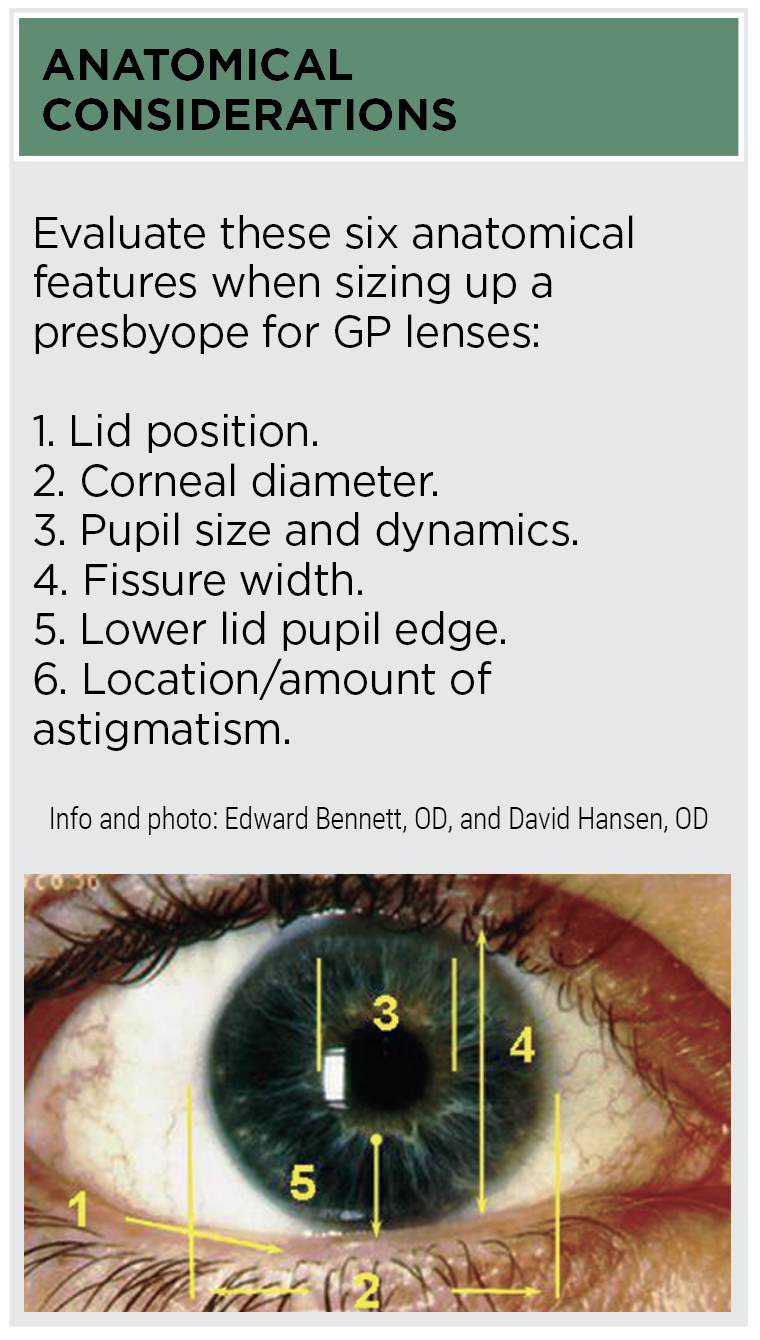 |
EDOF Designs
A popular new alternative in simultaneous vision has come in the form of EDOF optics. These power profiles use an aperiodic, non-harmonic variation in power, allowing them to be less influenced by pupil size and lens decentration. EDOF designs create an optical “pinhole effect” to provide a range of clear vision rather than one or two focal points. This would still be considered simultaneous vision, so adaptation to the optics is important, just like with aspherics.7
Alternating/Translating Designs
The alternative to simultaneous vision is an alternating or translating design. These lenses are fit to stabilize on the lower lid and move on the surface of the eye. This movement allows for the patient’s visual axis to focus through different zones of the lens. These lenses are highly customizable, with adjustable segment heights to ensure the patient can comfortably work in the various zones. They are stabilized through prism-ballasting and/or truncation methods. Ideally, these patients have a lower lid position at, or just above, the lower limbus. This type of lens is excellent for patients with the most critical vision demands due to their customization.5,7
Now that we’ve explored the advantages and disadvantages of the different lens designs, below we’ll take you through the gamut of RGP multifocals available today, pointing out along the way the features that set each apart.
Hybrid GP Lenses
Patients who desire better vision at near, intermediate and distance, as well as post-LASIK and keratoconic patients, may benefit from this type of lens. Here are a few hybrid MF CLs available today.
CooperVision
This company—one of the “Big Four” in this space—augmented its rigid MF portfolio after recent acquisitions of Blanchard in 2019, GP Specialists in 2020 and SynergEyes in 2022. SynergEyes and Duette lenses come in sphere powers up to ±20.00D and can correct up to 6.00D of corneal astigmatism.
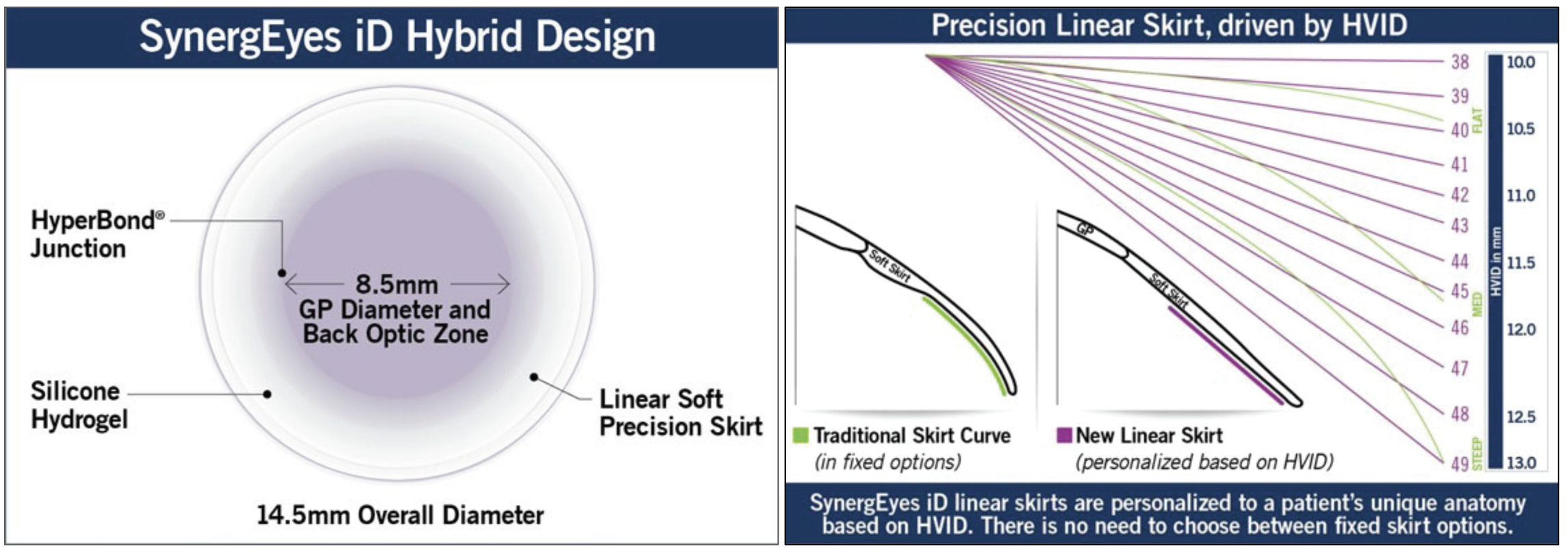 |
|
Fig. 2. SynergEyes iD MF EDOF design is fit empirically based on HVID, corneal curvature and refractive error. The linear skirt, personalized for each lens, promotes oxygen permeability and reduces the risk of tight lens syndrome. Photo: CooperVision. Click image to enlarge. |
• SynergEyes iD Multifocal EDOF. This lens, available since early 2021, has a silicone hydrogel skirt and high-Dk center (hemlarafilcon A/Dk 84, petrafocon A/Dk 130) treated with a polyethylene glycol coating for moisture. The personalized lens skirt is designed with a linear profile to improve comfort and reduce the risk for tight lens syndrome by promoting greater oxygen permeability. This MF option comes in three add powers and has a continuously changing non-monotonic and aperiodic power profile that differs from a zonal bifocal, aspheric or diffractive MF design. The iD Multifocal is ordered empirically based on HVID, corneal curvature and refractive error (Figure 2).
• SynergEyes Multifocal. This lens predates the SynergEyes iD Multifocal. This earlier MF design comes in four add powers up to +2.25D and two near-zone sizes. The Dk of the GP portion is slightly lower than the iD Multifocal (100Dk), and the skirt is made of low-Dk HEMA material.
• Duette Progressive. This lens has been available since 2018 and is made of the same materials as the SynergEyes iD Multifocal. It offers a progressive center-near design with add power up to +2.50D and a center-distance design with add power from 0.75D to +5.00D. A design feature that CooperVision calls “FlexOptics” gives the lens an adjustable center zone size based on pupil size. The Duette Progressive is ordered empirically based on HVID, corneal curvature, photopic pupil diameter, refractive error and required add power.
• Duette Multifocal. The oldest of these four lenses (and least customizable), the Duette has been on the market since 2011 and is made of the same materials as the other Duette lenses (hemlarafilcon A and petrafocon A). It comes in seven base curves, four skirt curves and two different sizes of center-near add zones. While this lens is certainly a viable option, patients who would benefit from a more customized fit and wider range of parameters may wish to consider one of the newer Duette or SynergEyes designs.
Scleral MF Lenses
Patients with irregular corneas or severe dry eye are often fit with scleral lenses and given the option of monovision correction or reading glasses despite the availability of an MF as an add-on in many of the scleral lenses on the market. For patients who may benefit from a scleral multifocal, here are some of the options at hand.
ABB Optical Group
• The Atlantis scleral lens offered by this company can be made with an add power up to +4.00D with adjustable distance zones (3.6mm to 4.4mm). This lens comes in base curves 6.50mm to 9.12mm, diameter 14.0mm to 17.5mm, sphere power ±20.00D, cylinder up to -5.00D and adjustable periphery including toric haptics and quadrant specific control.
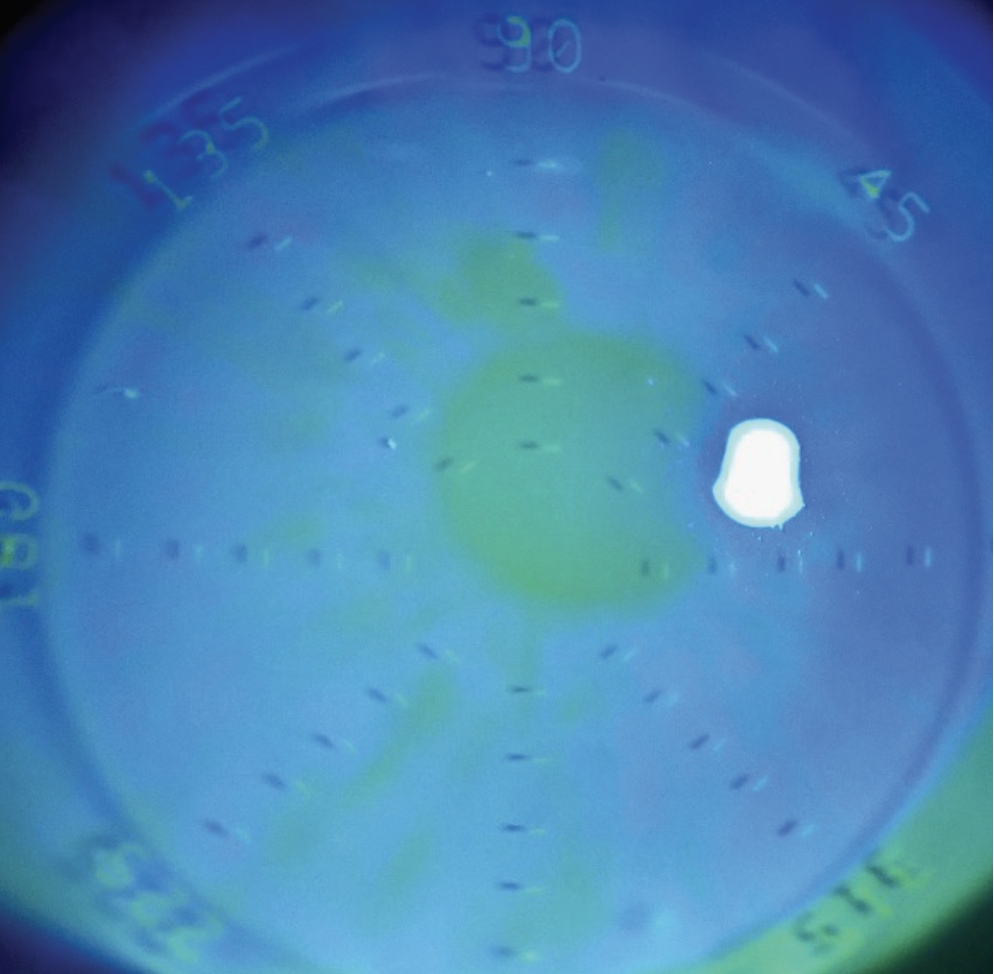 |
|
Fig. 3. A diagnostic Maxim scleral lens with alignment markers measuring three hash marks of decentration along the 45° meridian. With a larger diameter than Acculens’ “EasyFit” scleral, this lens is intended for irregular corneas. Photo: Acculens. Click image to enlarge. |
Acculens
• EasyFit and Maxim scleral lenses. These two scleral design profiles feature customizable center-near or center-distance aspheric options. The first of the two, which Acculens calls the “EasyFit” design, has a smaller diameter intended for the regular cornea patient, while the “Maxim” design is larger for intended use on irregular corneas, such as in keratoconus (Figure 3). Both offer decentered MF optics, which offset the central zone to realign with the pupil center after a lens decenters on eye. This can be achieved with measuring decentration directly through a laser-etched diagnostic fit set or empirical measurement.4
Advanced Vision Technologies (AVT)
• Naturalens scleral, Naturalens mini scleral and AVT scleral. These are three designs by AVT that are available in an MF design. These lenses can accommodate up to +3.50D add power and consist of a central distance zone surrounded by an aspheric intermediate zone, then a concentric near zone followed by a peripheral distance zone. A sophisticated fitting guide uses the HVID and a diagnostic fitting to adjust central, intermediate and peripheral alignment. Front toricity, toric haptics, notching and flexure control can be added. These sclerals come in the following diameters: Naturalens scleral, 15.0mm to 20.0mm; Naturalens mini scleral, 13.8mm to 15.5mm; and AVT scleral, 15.0mm to 22.0mm.
Art Optical
• The SoClear progressive is designed for patients with corneal ectasia. This corneal-scleral lens is available in base curves 6.6mm to 9.5mm, sphere powers ±20.00D, add powers up to +3.50D, adjustable peripheral curves and a diameter from 13.0mm to 15.0mm. The center-near zone can adjust from 0.5mm to 6.0mm.
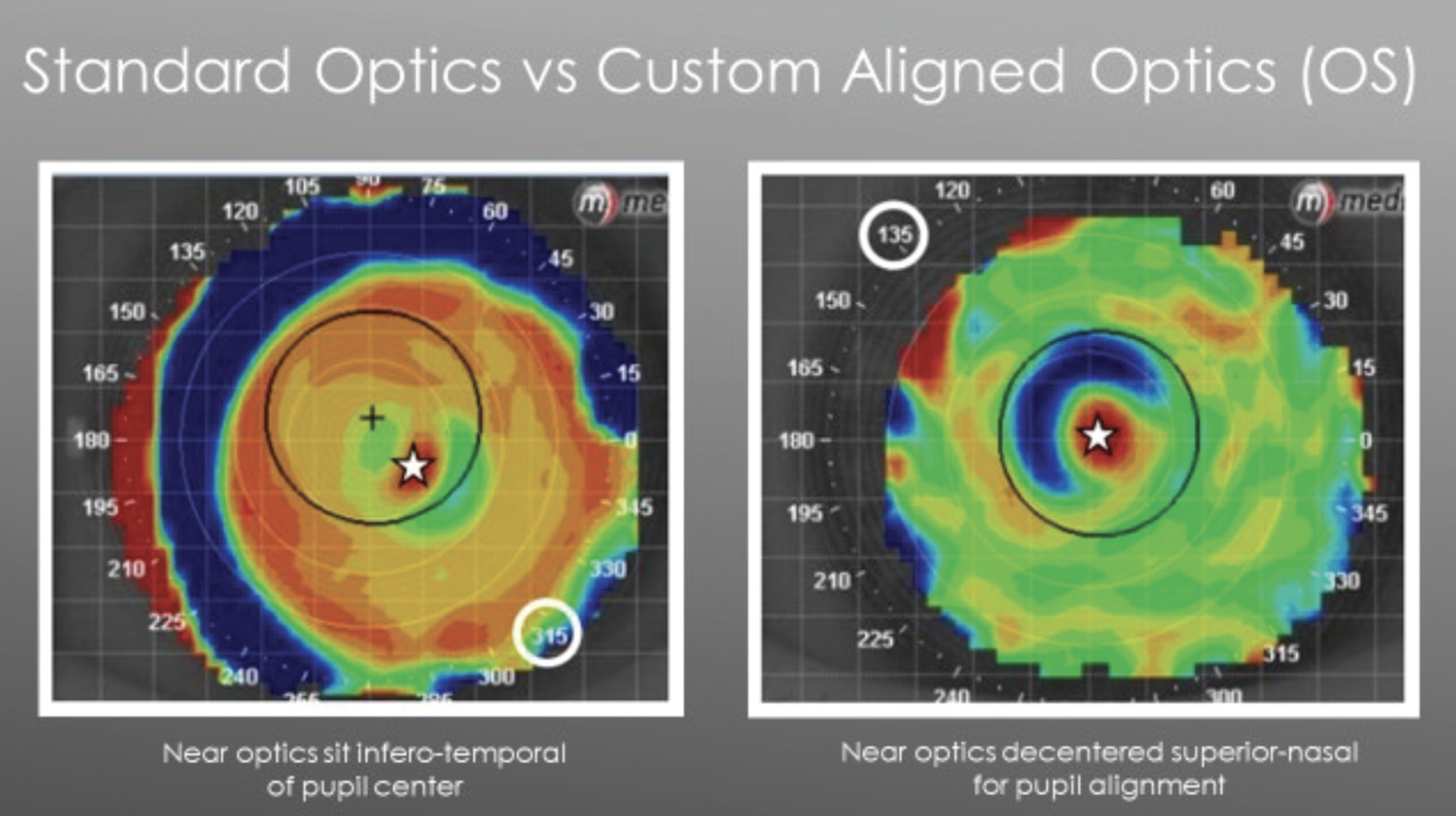 |
|
Fig. 4. The Ampleye scleral MF can incorporate decentered MF optics by determining the direction and amount of decentration by measuring topography over top the initial MF trial (left) then manufacture a new lens with recentered optics (right). Photo: Art Optical. Click image to enlarge. |
• Ampleye scleral MF. This center-near design lens employs a feature the company calls “custom aligned optics.” This allows the clinician to compensate for scleral lens decentration, which is often present due to scleral elevation differences, lens mass and/or lid interaction (Figure 4). The feature also decenters the MF add from the geometric lens center so that when placed on the eye, the optics are positioned directly in front of the pupil as desired. The amount and direction of decentration can be customized as needed. The lens is available in add powers from +1.00D to +3.50D and center-near zone sizes from 1.0mm to 4.0mm.
Bausch + Lomb
• Zenlens MF scleral. This lens was launched by B+L in 2019 and is a viable option for patients with scleral abnormalities, such as pingueculae or filtering blebs. It features a broad landing zone on the sclera, as well as a feature that the company calls “MicroVault technology,” which allows for vaulting over scleral obstructions. It comes in four diameters (14.8mm to 17.0mm), oblate and prolate designs and the option to correct for residual astigmatism with front-surface toric optics. Another unique feature of this lens, which B+L calls “SmartCurve,” allows the intermediate (limbal clearance) curve to be changed without affecting the SAG and peripheral curves.
The Zenlens can also adjust for the toric nature of the sclera. The center-near multifocal optics are centered over the visual axis instead of the center of the pupil for sharper acuity (Figure 5). This is generated by measuring add power, pupil size, eye dominance and lens rotation.
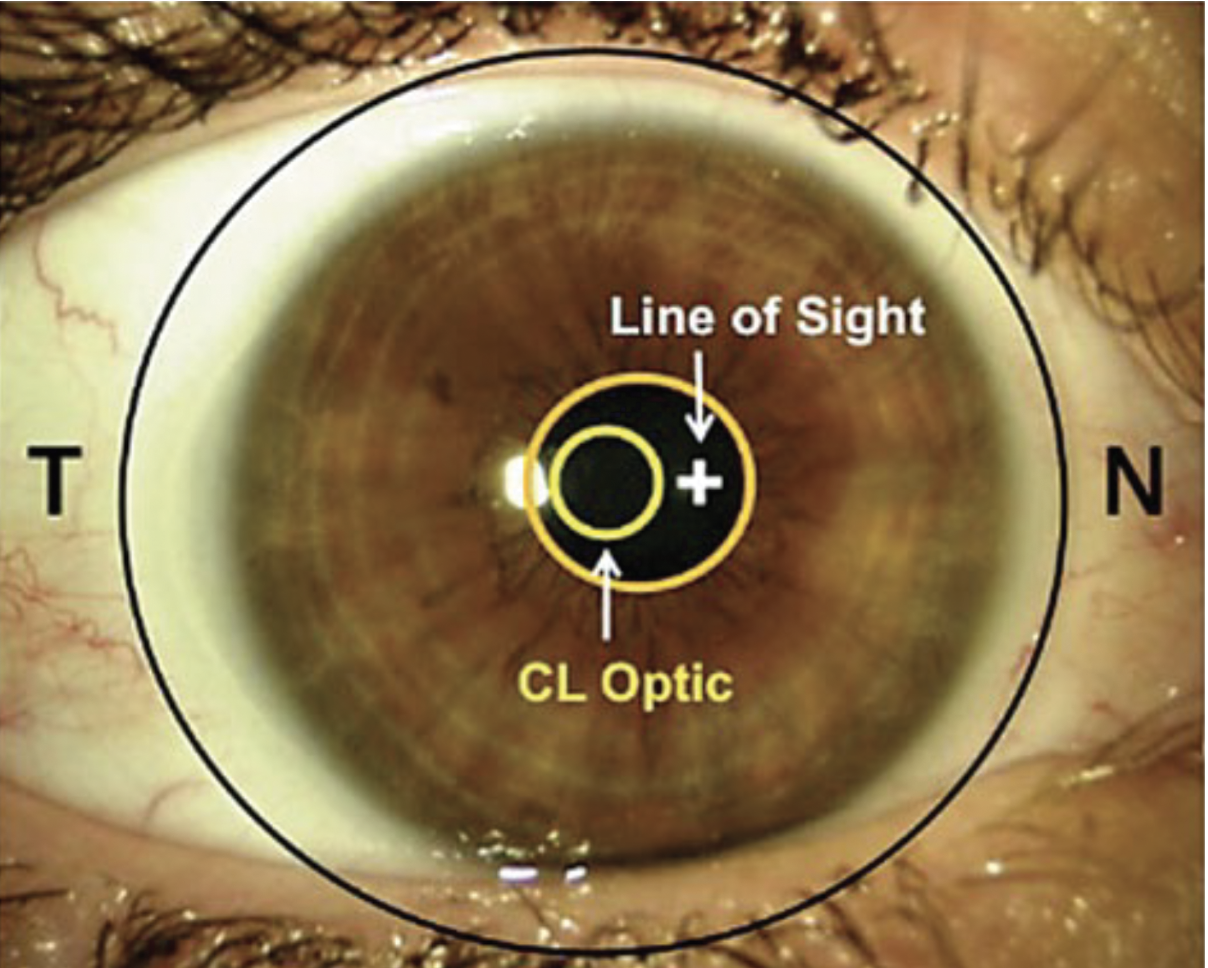 |
|
Fig. 5. The optical center of most lenses aligns with the pupil center and cornea, which are inferior and temporal of the line of sight. The Zenlens allows alignment of the visual axis and the center of the near zone for better acuity. Photo: Matthew Lampa, OD. Click image to enlarge. |
Blanchard
• Onefit Scleral. Blanchard, now owned by CooperVision, offers this MF lens, which employs smaller diameters (14.7mm and 14.9mm) with minimal mass and corneal clearance, intended to provide optimal oxygenation, stability and convenience. Designed for both regular and irregular corneas, features to enhance fit include: a front-toric option (Sym-Toric) combined with toric haptics for residual astigmatism and maximum lens stabilization; a feature that accommodates scleral elevations; an option called “central clearance reduction” for oblate post-surgical corneas; an option to add extra limbal clearance for boosted edge lift; and, finally, an adjusted near-zone diameter for the dominant and non-dominant eye (“D” and “N” lens; Figure 6).
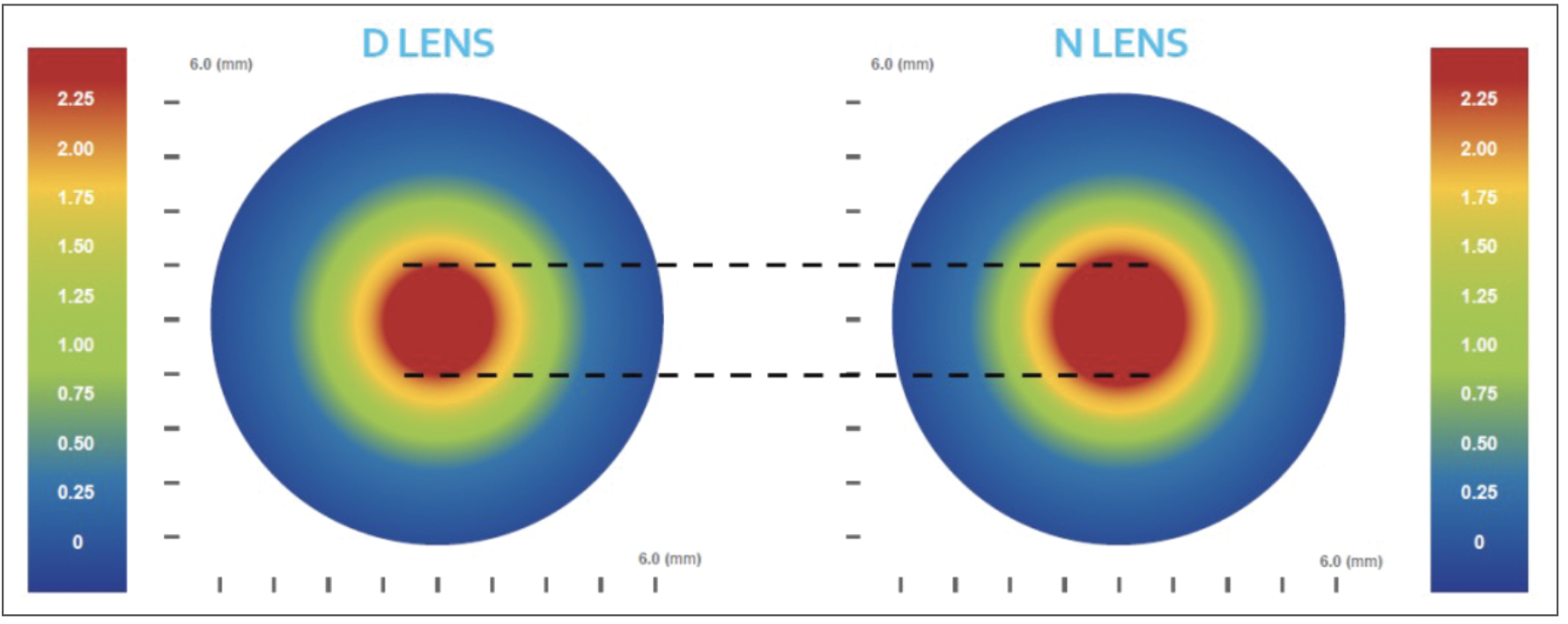 |
|
Fig. 6. The Onefit scleral lens MF features an adjustable near-zone diameter for the dominant (“D” lens) and non-dominant (“N” lens) eye. Photo: Blanchard. Click image to enlarge. |
Menicon
• The Rose K2 XL is a popular option for patients with irregular corneas. This highly customizable semi-scleral lens comes in a center-near simultaneous vision design with a front-surface add power. It comes in base curves 5.6mm to 9.0mm, diameters of 13.6mm to 16.6mm and adjustable front optic zone adjustment from 0.5mm to 5.0mm.
Metro Optics
• InSight Scleral is a lens that is compatible with both regular and irregular corneas. It comes in base curves from 32.0mm to 67.0mm, sphere power +20.00D to -25.00D, cylinder power up to 8.00D in 5˚ steps, diameters 14.0mm to 18.2mm, spherical or toric periphery and a center-near aspheric MF up to +3.00D add power.
Valley Contax
• The Custom Stable Aurora scleral lens is a front-surface MF that uses a dominant (distance-center)/non-dominant (near-center) system that works in unison with the patient and accommodative demands. Decentration can be measured topographically or with the XWave aberrometer (Ovitz). The customization of MF designs in the Custom Stable platform is a great starting point for scleral MF fitting. This can be used on irregular cornea and dry eye patients, as well as for high or out-of-range refractive errors. If vision remains suboptimal, the decentration option with Ovitz is a great troubleshooting tool.
Visionary Optics
• The Jupiter Plus lens is a center-distance lens with an add power of up to +1.75D, diameter 15.0mm to 18.2mm, sphere powers ±20.00D and custom features such as oblate geometry and toric haptics.
• The Europa Scleral was developed as an advance on the Jupiter scleral lens. It is available in a center-near and center-distance design. Additional features include a highly customizable periphery to vault scleral elevations, quadrant-specific steepening and flattening and front and back toricity. Intermediate curves can be precisely adjusted, as well.
• The Latitude Scleral conforms exactly to the shape of the sclera. It requires profilometry (corneo-scleral topography mapping) and can be ordered in an MF option.
• The Elara for Presbyopia 15.0mm prolate scleral lens is a concentric center-near bifocal with a maximum +3.50D add power and an adjustable center zone from 1.0mm to 3.5mm. Since this lens employs a center-distance design, toric optics and toric haptics are options. It is designed for regular corneas for patients with dry eye that desire the visual acuity of a rigid lens.
Corneal GP Lenses
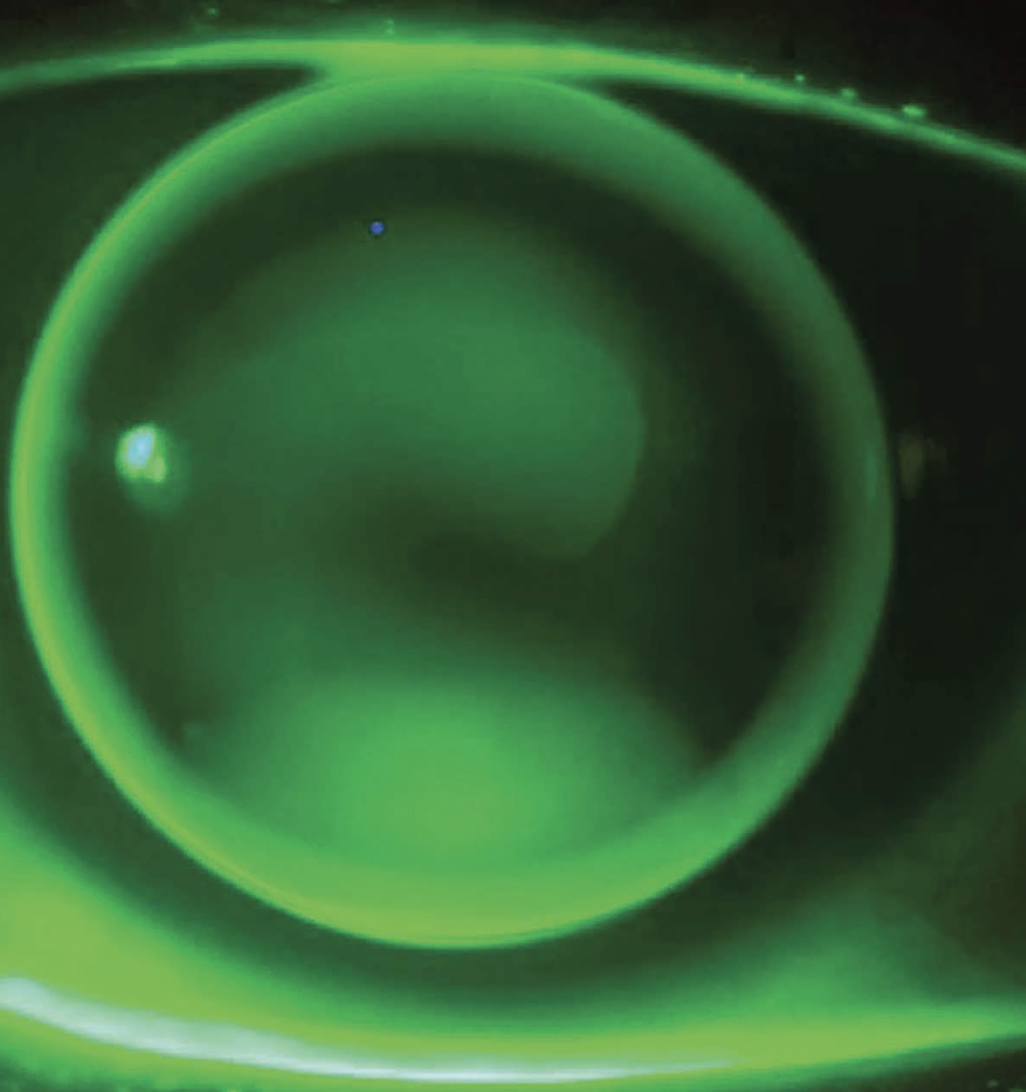 |
|
Fig. 7. Corneal GP MFs are available in translating, concentric and aspheric lens designs. They can be fitted for patients with keratoconus, corneal astigmatism, presbyopia and other vision concerns. Photo: Tiffany Andrzejewski, OD, and John Gelles, OD. Click image to enlarge. |
These lenses—available in translating, concentric and aspheric designs—are often considered the top choice for managing keratoconus, but they can also target many other vision concerns, such as corneal astigmatism, presbyopia or post-refractive surgery eyes (Figure 7). Here are the options.
ABB Optical Group
• The Mandell Seamless multifocal has a front-surface concentric design up to +3.00D in add power providing a customizable seamless transition between the spherical distance and near optic zones. It is available in a reverse curve and astigmatism correction.
• The Natural Vision Bifocal is a translating, truncated and prism-ballasted lens design with a spherical near and distance zone that are customizable.
• The Versare features what ABB Optical Group calls “controlled zone technology,” allowing easier transition from the distance zone into the near zone. This lens is ideal for emerging presbyopes with less than 2.00D corneal astigmatism, providing up to +2.00D add power.
• The XTriVision is a simultaneous vision MF lens that allows a customized optic zone size and up to +3.00D of bifocal add power. It is also available in a back-toric design and reverse-geometry profile.
• The Tangent Streak comes in a simultaneous-focus “no line” multifocal lens designed for emerging presbyopes with significant corneal astigmatism, as well as a more traditional choice: a translating segmented bifocal and trifocal lens design for optimal distance and near acuity and higher reading power corrections.
AVT
• The Naturalens GP family provides the option of a center distance with concentric intermediate and near zones MF with the “mid pro” design having a wider distance zone and the “pro” a wider near zone. Front-toric and bitoric designs, as well as toric peripheral curves, are available. The edge is designed to create “tear cushions” and a reduced edge lift to improve comfort and promote tear exchange. The lenses come in a 9.0mm to 11.5mm diameter. Those for irregular corneas (i.e., the Naturalens VIP cone) can have an MF option added.
• TransbyLite. This translating MF is designed for normal and irregular corneas with an add power up to +3.50D. It is available in a spherical and bitoric design, a wide range of base curves, sphere and cylinder powers and a diameter range of 7.0mm to 12.0mm.
• Varifocal, Varifocal Plus and Varifocal High Add Plus. Each of these is a back-surface center-distance MF with a back-surface aspheric blend to a peripheral near zone that comes with the option of a front-surface toric for residual astigmatism. They come in a wide variety of base curves and sphere and cylinder powers, in a diameter range from 7.0mm to 12.0mm.
• The Pediasite. Suitable for children with pediatric aphakia, this high-Dk lens may be preferred over a soft aphakic CL in cases of corneal irregularity. To reduce amblyopia risk, it has the option of an MF lens and comes with a VIP edge design in a wide range of spherical and cylindrical corrections and diameters ranging from 8.5mm to 11.5mm.
Art Optical
• The Renovation MF is best suited for add powers over +2.25D and has an adjustable front-surface and base-curve eccentricity that reduces spherical aberration and easy translation into the near zone. Adjustment of the distance zone to accommodate pupil size and lens thickness to maximize lens centration and wearing comfort are both available options. A diagnostic lens set comes in base curves 7.2mm to 8.3mm, diameter 9.2mm and 9.5mm and +2.50D add power.
• The Expert Progressive is a segmented lens that provides equal thickness at the 360° edge. The distance-to-near transition is blended, and this “intermediate” zone is customizable. This lens comes in base curves from 6.90mm to 9.00mm, diameters 8.5mm to 10.0mm, an add power of up to +4.00D and power range ±20.00D.
• ClasikCN is a center-near, reverse-geometry lens suitable for presbyopes with a history of refractive surgery. The design can be made empirically or using a diagnostic fit set.
• mPower! is a center-distance MF lens that uses multiple front-surface curves to improve near vision for patients who have failed with other MF designs. A diagnostic lens set comes in base curves 7.2mm to 8.1mm, diameter 9.5mm and +2.50D add power.
• The One Piece Bifocal has a prism-ballasted segment bifocal and high-definition optics to reduce blur often caused by the transition line. It is designed for higher presbyopic demands and those who have had problems with simultaneous-vision MF lenses, especially those with high corneal cylinder.
Bausch + Lomb
• The Boston MultiVision lens, which has been around since 1997, uses a posterior-surface multi-aspheric design manufactured exclusively in the Boston ES material. The 9.6mm diameter lens is available in 11 base curves (7.3mm to 8.3mm), sphere powers ±20.00D, an add power of +1.50D and multi-aspheric posterior curves. The low add makes this lens most suited for emerging presbyopes.
Blanchard
• The Essential lens functions as both a translating and simultaneous-focus lens with a flatter back-aspheric surface to reduce risk of corneal molding. This lens, as well as the other two from this company described next, use a unique manufacturing process that creates a greater add power and promotes better contrast sensitivity. Clinicians also have the option to add a front-surface annular component that creates a translating aspheric MF. The lenses come in base curves from 6.9mm to 8.3mm, diameters 8.8mm to 10.5mm and a front- and back-surface combined add power of up to +4.00D.
• The Reclaim HD Bi-Aspheric lens features an aberration-controlled aspheric center-distance design that provides up to +4.00D add power. It comes in base curves 7.0mm to 8.3mm, diameters 8.8mm to 10.2mm and sphere powers ±20.00D. The anterior distance zone is also adjustable from 2.0mm to 4.0mm.
• The Refractive Surgery Specific lenses come in an MF option and feature a reverse-geometry aberration control design to fit flat corneas. Lenses come in fitting curves 7.34mm to 8.65mm, with central base (reverse) curves 1.00D to 9.00D flatter, diameters 9.5mm to 12.0mm and sphere powers ±20.00D.
Conforma
• Variable Focus Lens3 (VFL3). This is a progressive center-distance lens designed to minimize aberrations while providing a maximum add power of +2.25D. The lens comes in base curves from 6.7mm to 8.0mm with adjustable peripheral curve and a recommended diameter of 9.4mm. Recent design developments include an aspheric front surface in the VFL3 HD that adds +0.50D add power, followed by additional front aspheric add power increases in the VFL3 HD-AP and the VFL3 HD-CAP.
Essilor
• ContinuVu and ContinuVu Plus. These back-surface center-distance lenses have a +1.75D progressive add power. The “Plus” lens offers the option of a front-surface add for a total power of up to +4.00D. Lenses come in base curves 6.0mm to 10.5mm, diameters 8.2mm to 11.6mm and sphere powers ±25.00D. These lenses center well and have a reduced risk of corneal molding.
• MVP and MVP BiToric are aspheric MF lenses with add powers up to +4.00D, base curves 4.7mm to 11.26mm, diameters 8.0mm to 12.5mm and sphere powers ±32.00D.
• The Flex-3 MF has a concentric trifocal center-distance design of up to +3.50D add power that does not employ asphericity, eliminating the risk of corneal molding. Lenses come in base curves 7.0mm to 8.5mm, diameters 9.6mm to 10.0mm and sphere powers ±20.00D.
• The EZEyes combines a progressive back surface with a full add power up to +4.00D in a front-surface bifocal segment. Lenses come in the same parameters as the MVP.
• The Vision Plus 2 MF is a bi-aspheric center-distance lens with a large intermediate zone provided by V-Plus aspheric optics and a rapid increase in the up to a +4.00D add power. Lenses come in the same parameters as the EZEyes and MVP lenses.
• The Expert Progressive, like the EZEyes lens, combines a segmented with a progressive add power that is designed to have less awareness of the prism segment. Lenses come in an add power up to +4.00D, base curves 6.5mm to 8.6mm, diameters 8.0mm to 12.0mm and sphere powers ±25.00D.
Lens Mode
• The Hi Rider MF offered by this company is unique in that it allows a single-vision lens to be converted to an MF without altering the fit. It’s available with up to +3.75D add power.
Metro Optics
• The Metro Progressive Aspheric is a center-distance lens with a 2mm central back-surface spherical curve surrounded by aspheric peripheral curves and a spherical front surface. It comes in base curves from 5.45mm to 10.55mm, sphere powers ±10.00D and diameters 8.8mm to 9.8mm. The Metro Progressive has an add power of up to +2.00D, while the Metro Enhanced Progressive provides up to +2.75D add power.
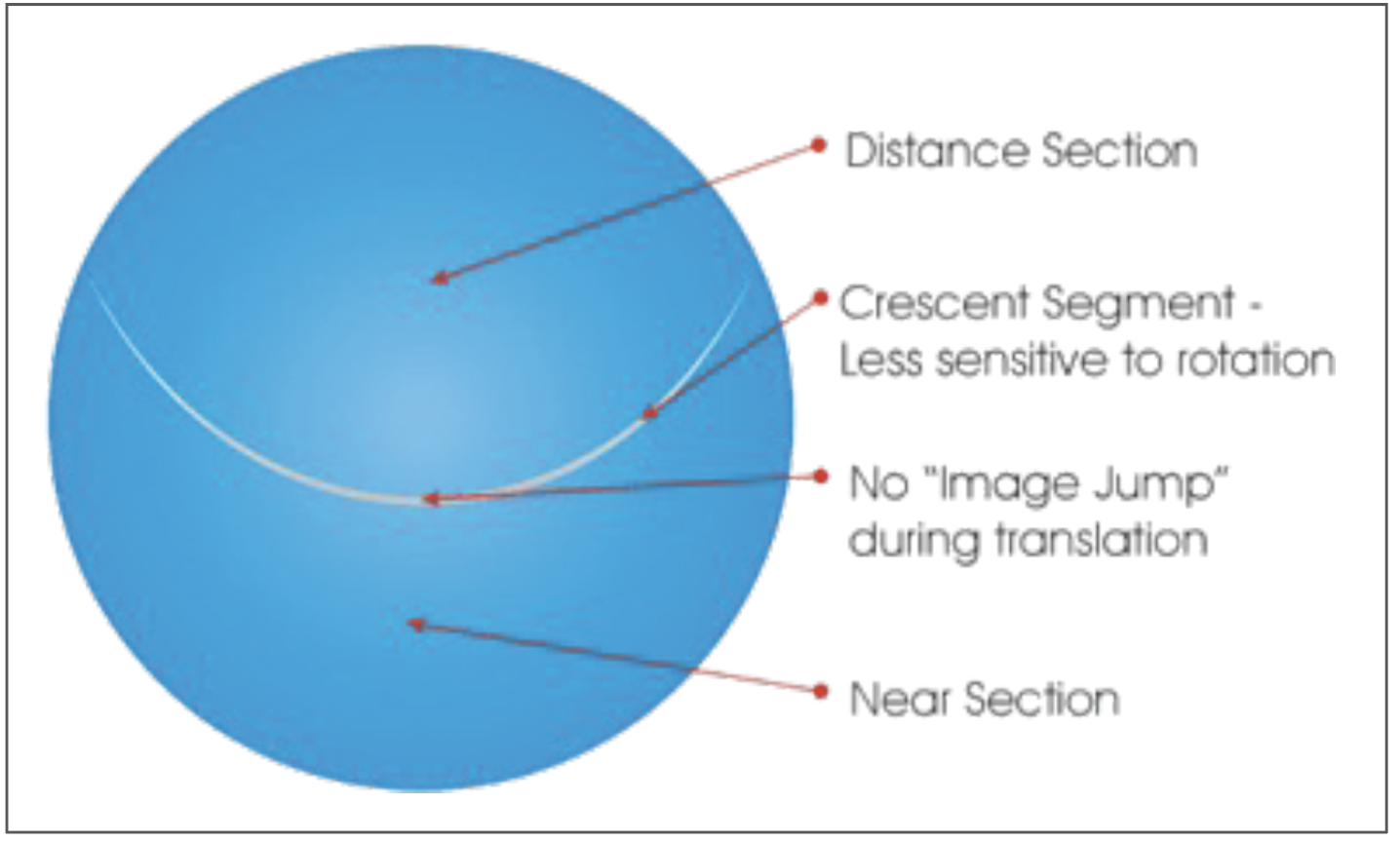 |
|
Fig. 8. Metro-Seg Crescent Bifocal is a translating design from Metro Optics. Optical centers of the distance and near lens are close together for an uninterrupted transition from near to distance. Photo: Metro Optics. Click image to enlarge. |
• The Metro-Seg Crescent Bifocal is a translating design that comes in base curves of 5.45mm to 10.55mm (32.00D), sphere powers of +10.00D to -20.00D, diameters 9.0mm to 9.8mm and has available toric parameters. The practically unlimited add power is positioned in a crescent segment that allows near vision to remain stable with mild lens rotation. The optical centers of the distance and near lens are placed close together to minimize image jump when transitioning into the bifocal segment (Figure 8). The seg height can be varied from 0.3mm to 1.2mm below the geometric center.
Precision Technology
• The Apex is a center-distance 10.5mm standard-diameter MF that has an aspheric back surface for a comfortable and stable fit based on pupil size, HVID, keratometry and refraction.
• The Apex TriAdd combines simultaneous vision and translation design with separate zones of spherical radii that transition using an aspheric filet curve to achieve a progressive power effect and a front-surface add with an adjustable pupil diameter to optimize distance, intermediate and near acuity. The preferred diameter is 9.6mm, and while the distance zone can be adjusted from 2.0mm to 4.0mm, the recommended size is 2.9mm for the non-dominant and 3.2mm for the dominant eye.
The LifeStyle GP Company
• The LifeStyle GP is a center-distance aspheric MF that allows for additional add power on the front surface (up to +3.75D total). This is a traditionally high-riding lens in primary position that translates in downgaze to allow close vision through an aspheric alignment curve. Lenses come in base curves 7.0mm to 8.9mm, diameter 9.0mm to 10.5mm and sphere powers ±20.00D with an adjustable distance zone from 3.0mm to 6.0mm.
• The LifeStyle Marquis GP is a center-distance aspheric MF with a large reading zone and a low (≤+1.75D) and high (≥+2.00D) add power. Lenses come in fitting curves 6.6mm to 8.9mm, a diameter of 9.5mm and sphere powers ±20.00D.
TruForm Optics
• The Llevations Thin Multifocal is a translating trifocal design that uses truncation and base-down prism to stabilize the lens on the lower lid. Two customizable seg heights can be altered to create variable intermediate and near zones with individualized powers.
Valley Contax
• The GoldenEye Aspheric Front Multifocal is a GP lens with a completely spherical back surface to fit the corneal curvature. It features a highly eccentric front surface to achieve smooth transition across vision distances. Ideal candidates are presbyopes who want to improve their quality of vision or any patient struggling to meet their visual needs with soft MF torics.
• The Buckley Bifocal is a prism-ballasted, segmented GP bifocal for patients who need quality distance and near vision and don’t care for aspheric designs. Add power goes up to +3.50D.
Visionary Contact Lens
• The Site-See Bifocal is a center-distance lens with concentric intermediate and near zones. It has a spherical or spherocylindrical back and aspheric front surface that allows for a progressive add (up to +4.00D).
X-Cel Specialty Contacts
• The Essential and Essential Solution multifocal lenses have a center-distance design with an aspheric back surface. The Essential Solution adds to this a translating front-surface bifocal add design providing up to +3.50D add power. The lenses come in a -10.00D to +6.00D sphere power and standard base curves from 7.1mm to 8.2mm and a diameter of 9.3mm.
• The Solution Bifocal is a prism-ballasted translating lens with one-piece construction and monocentric optics designed to eliminate image jump when moving between the distance and near segment. Add powers go up to +3.00D.
• The CV-4 Multifocal is a spherical back-surface center-distance progressive aspheric front-surface MF lens that is fit based on pupil size, corneal measurements and spectacle Rx. The lens comes in 6.8mm to 8.55mm base curves, 9.0mm to 10.0mm diameters, ±16.00D sphere powers and add powers up to 3.00D with an adjustable pupil diameter from 3.0mm to 5.5mm.
• ProPlus Multifocal is a bi-aspheric center-distance lens that is fitted using the patient’s HVID and spectacle prescription. The rapid rate of flattening in the near periphery provides clear intermediate vision. The lens comes in 6.9mm to 8.5mm base curves, 8.5mm to 11.0mm diameters, +10.00D to -15.00D sphere powers and add power up to 3.50D with an adjustable distance zone from 3.3mm to 3.9mm.
Conclusions
There are dozens of lens options to choose from in the hybrid, scleral GP and corneal GP categories, and new designs and materials will continue to join the market. Familiarize yourself with all the brands and parameters available to have the best chance at matching your patients with the most suitable lens.
Dr. Stokkermans is an associate professor at the Case Western Reserve School of Medicine, director of optometric services at University Hospitals Cleveland Medical Center and an adjunct faculty member of five optometry schools in the US. He is a fellow of the American Academy of Optometry, the chief editor of Optometry Advanced Medical Care at www.statpearls.com and a medical writer and reviewer at www.allaboutvision.com. He has participated in over 30 contact lens trials. He discloses financial relationships with BioTissue and Tarsus.
Dr. Gidosh is assistant professor at the Pennsylvania College of Optometry. He serves as chief of the Cornea and Contact Lens Service at The Eye Institute and has presented lectures and workshops in PCO’s Advanced Studies Program and International Program on topics including scleral and hybrid lenses, irregular cornea and contact lens fitting. He is a Fellow of the American Academy of Optometry and has served as a clinical investigator for studies involving hybrid, scleral, multifocal and orthokeratology lenses, presenting lectures and posters at national and international conferences on these topics.
1. Ortiz-Toquero S, Martin M, Rodriguez G, et al. Success of rigid gas permeable contact lens fitting. Eye Cont Lens. 2017;43(3):168-73. 2. Michaud L, Bennett ES, Woo SL, et al. Clinical evaluation of large diameter rigid-gas permeable versus soft toric contact lenses for the correction of refractive astigmatism: a multi-center study. Eye Cont Lens. 2018;44(3):164-9. 3. Nichols JJ, Fisher D. Contact lenses 2022. Contact Lens Spectrum. January 1, 2023. 4. Review of Cornea & Contact Lenses. Annual contact lens and lens care guide. July/August 2023. 5. Watanabe R. Modern GP MF lens designs. Cont Lens Spec. 2010;25(10):20. 6. Nguyen T, Schinas Z, Najman P. Expand your horizons: think GPs for presbyopes. Review of Cornea & Contact Lenses. September 2017;26-27. 7. Davis RL, Schwartz M. Seeing multifocal optics more clearly. Review of Cornea & Contact Lenses. June 2021;16-20. 8. De Leon M. MF optics explored. Review of Cornea & Contact Lenses. March 2020:18-21. |


